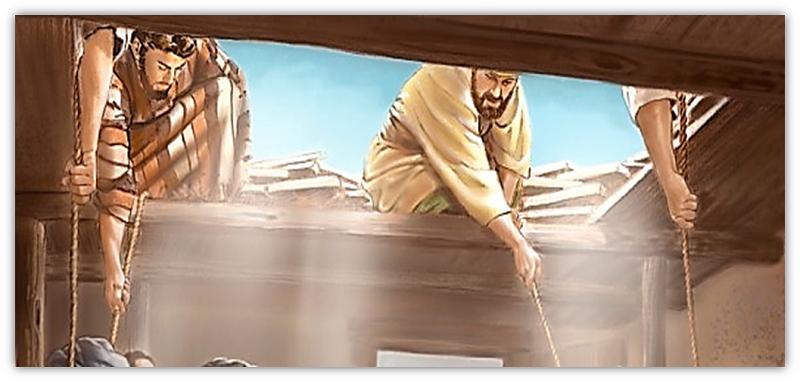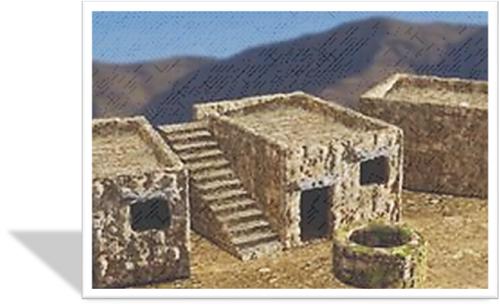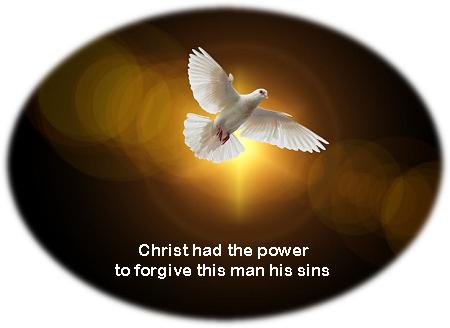The Healing of the Paralytic
The Healing of the Paralytic
Read Luke 5:17-26

If the cleansing of the leper demonstrated what Christ can do with the pollution of sin, the healing of the paralytic shows what God can do with the inability that comes because of sin. Among the hosts of problems sin brings with it is this: sin disables sinners so they cannot come to Christ. This miracle before us proves that even when sinners have no power, Christ has “power on earth to forgive sins.” Let’s trace this point in six particular scenes.
Power⤒🔗
Christ was teaching in a house in Capernaum. Many gathered to hear Him – so many that the house was full and people were pressing in around the door. Though Matthew (Matt. 9:1-8) and Mark (Mark 2:1-13) record this incident as well, the evangelist Luke uniquely mentions an interesting detail: “...the power of the Lord was present to heal them” (v. 17). Just prior to this (v. 16), we are told that Christ had been praying in the wilderness. The histories of nations, peoples, churches, and individuals contain times of power that usually came after special seasons of prayer. Remarkably, though it is noted that Christ had power to heal, so far this day there was no healing going on. That would soon change.
Powerlessness←⤒🔗
“Sick of the palsy” means, paralyzed, likely from the waist down. What a contrast from how God created us, physically and spiritually. Spiritually speaking, God made us so that we can stand and walk in the light of His face. However, by our sins, we cannot stand upright, nor walk before Him as we ought.
Despite his miserable condition, this paralytic man had a great blessing, namely, four friends who cared for him (v. 18). How wonderful it is to have even one friend, much more four true friends! We don’t know much about them, except that these five all shared one thing – faith (v. 20). The Holy Spirit had implanted in these men the persuasion that Christ was able to help them. However, the crowd at the house where Christ was that day prevented their access to Him. Despite their persuasion of Christ’s ability, Christ was hidden and inaccessible to these men.
There is a spiritual lesson here. Many who hope that Christ can do something for them, turn away from seeking Him when they face obstacles. True faith, however, distinguishes itself by persistence.
Persistence←⤒🔗
Houses in Israel at this time often had an exterior staircase that led to a flat roof. Unable to get through the door, these five men make their way up the stairs to the roof (v. 19). The people in the house likely would have heard the noise of heavy feet clanking around; but Christ continued teaching, and the five men likely strained to listen to where Christ’s voice was coming from to discern where to open up the roof. Roofs back then would have been made of rough rafters with branches or tiles plastered together with something like mud that had dried. It might not have been that difficult to break them apart; however, it would have been unusual and messy to do so while Christ was in the house teaching: imagine pieces of baked mud falling from the ceiling! Yet true faith is not easily intimidated.
Spurgeon writes:
When four true hearts are set upon the spiritual good of a sinner, their holy hunger will break through stone walls or house roofs.

This persistence lasted as long as it took to let this man down “before Jesus” (v. 19). What a beautiful phrase! True faith always runs until it comes “before Jesus.” Like iron moving towards a magnet, so faith moves until it clings to Christ. Faith does not have this power in itself, but it is driven by need. Ultimately, it wasn’t some power in faith that saved this man; Christ saved him by faith. The Spirit of God drove the faith of these five men until they came with all their powerlessness to the only powerful One.
Pardon←⤒🔗
What a remarkable picture the Scripture paints in verse 19: a powerless sinner in front of a powerful Savior. Remember how Luke noted that there was “power present to heal” (v. 17). Now, finally, here was an object to heal. However, it is not physical healing that Christ does first. Christ saw beyond this man’s misery to the root cause of it, and He addresses the cause before He addresses the result. We can be thankful when the Lord teaches us our real problems. “Man, thy sins are forgiven thee” (v. 20). Notice the following about the pardon Christ issued to him:
- It was authoritative pardon. His words and tone evidenced this authority, but Christ also demonstrated that authority, as we will see below (see v. 24).
- It was substitutionary pardon. He could issue this pardon because He would die for this man’s sin on the cross.
- It was defended pardon. Right away, the Pharisees dispute this pardon (v. 21). This must have confused the man at a certain level. Yet, Christ took the side of the pardoned sinner, shielding him against this devilish attack. He defended the pardon by pointing to Himself, and proved it by the actual healing.
Proof←⤒🔗
Christ not only perceived the faith of the five before Him; He also was able to look into the hearts of the Pharisees. “But when Jesus perceived their thoughts...” (v. 22). The Pharisees were offended that Christ would forgive this man his sins. Notice the enmity of men – even religious men against free grace. This enmity targeted the Savior Himself. Nevertheless, by healing the man, Christ proved that He had power to forgive this man his sins.
Christ eminently proved that He had power to forgive sin when He died for sinners on the cross, paid their debt, and rose again. He proved it in His ascension and at Pentecost, and now He proves it over and again in the gospel when He delivers sinners from their sins.
Sadly, many are content to examine the power instead of experiencing it. Many are content to observe rather than obey. Luke mentions that “there were Pharisees and doctors of the law sitting by” (v. 17).
Such people always exist. They are content to be religious onlookers, but they never feel their spiritual paralysis. Others, however, feel their sin and perhaps wonder: Can God forgive me? Christ proved here that He has power on earth to forgive sins. Do not be turned back by obstacles. Don’t rest until you come to His feet.
Praise←⤒🔗
When the Son of Man forgives and heals, there will be praise! The man who had been forgiven and healed rose up before the crowd, took up his stretcher, and departed, glorifying God. Others couldn’t help but join this man. They too “glorified God, and were filled with fear, saying: We have seen strange things today” (v. 26).

A true experience of God’s forgiving grace cannot but lead us to praise God. We will call on others to come and hear what God has done for our souls (see Ps. 66:16-17).
Questions←⤒🔗
- Christ’s miracle here proved something about Himself and what He had come to do (v. 24). What point can we draw from this regarding the other miracles Christ performed?
- A recurring promise in the Old Testament was that God would come and pardon His people’s sins (see, for example, Isa. 43:35; Jer. 31:35; Mic. 7:18-20). Many, also today, crave miracles that will make their life here better, but not those that save the soul. How does this miracle convict us on this point?
- Spiritually speaking, how can we be used, like these four friends, to bring others to Christ? Where might we look for such people like this paralytic?
- What lesson do you take from the fact that Christ gladly bore the disturbance and mess caused by these five men for the sake of having a needy sinner come to His feet?
- How could the Pharisees seem to be so concerned with the honor of God and yet so wrong (v. 20)? What lesson does this teach us?
- What are some of the obstacles sinners face as they seek to find and come to Christ now? What practical counsel can you give such seeking souls?

Add new comment